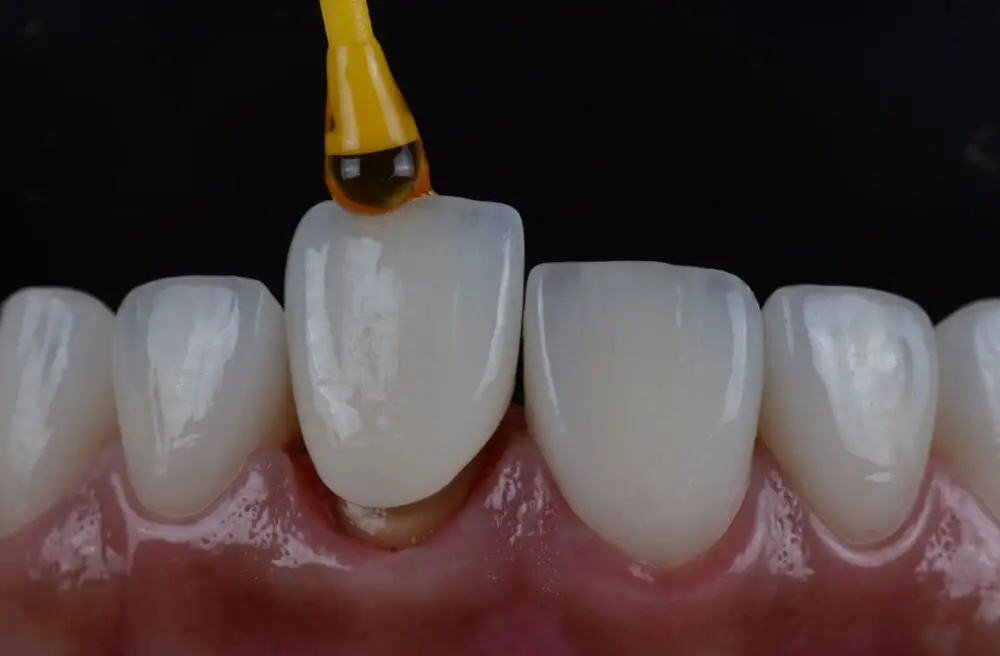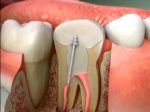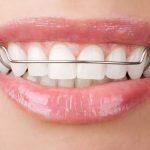Spotting the Signs: How to Identify a Cavity Between Your Teeth

Cavities are a common dental issue that many people face at some point in their lives. They occur when bacteria in the mouth produce acids that eat away at the tooth’s enamel, creating a hole or cavity. While cavities often occur on the surface of teeth, they can also form between teeth, known as interproximal cavities. These cavities may be more difficult to detect and treat, as they are not immediately visible and can go unnoticed until they become more severe. Identifying a cavity between your teeth requires careful observation and attention to detail. You may notice symptoms such as pain or sensitivity when biting down, food getting stuck between your teeth, or a visible hole or discoloration. Regular dental check-ups and cleanings can also help detect cavities before they become more serious. By understanding the signs and symptoms of interproximal cavities and taking steps to prevent and treat them, you can maintain good oral health and avoid more serious dental issues in the future.
Identifying cavities early is crucial to maintaining good oral health. Cavities, also known as dental caries, are areas of decay that can cause pain, infection, and tooth loss. When left untreated, cavities can spread and affect neighboring teeth, leading to more extensive dental work and even more serious health problems. Early detection of cavities allows for prompt treatment, which can prevent further decay and damage. Regular dental checkups and cleanings, along with good oral hygiene practices, can help identify and treat cavities before they become more serious issues. By taking a proactive approach to dental health, individuals can ensure a lifetime of healthy teeth and gums.
A cavity between your teeth is a common dental problem, and it can be quite difficult to detect until it becomes more severe. However, there are some common signs that you can look out for. One of the most noticeable signs is sensitivity or pain when eating or drinking something hot, cold, or sweet. You may also notice a small hole or pit in your tooth or a dark spot on the surface of your tooth. Other signs may include bad breath, a bad taste in your mouth, or swelling in your gums. If you notice any of these signs, it is important to see your dentist as soon as possible to prevent further damage to your teeth.
What Causes Cavities Between Teeth?

Cavities are one of the most common dental problems that people face. They are caused by a variety of factors such as poor oral hygiene, sugary and acidic foods, and bacteria. However, cavities between teeth are particularly problematic as they are often difficult to detect and can cause significant damage if left untreated. The main cause of cavities between teeth is the build-up of plaque. Plaque is a sticky film that forms on teeth when bacteria in the mouth combine with food particles. When plaque is not removed through regular brushing and flossing, it can harden into tartar, which can then lead to cavities. Another factor that can contribute to cavities between teeth is a lack of fluoride. Fluoride is a mineral that helps to strengthen tooth enamel and protect against the formation of cavities. If your diet is lacking in fluoride, or if your toothpaste or mouthwash does not contain enough fluoride, you may be at a higher risk of developing cavities. Other risk factors for cavities between teeth include dry mouth, which can be caused by certain medications or medical conditions, and a history of dental problems in your family. Regular dental check-ups and cleanings are essential for identifying and treating cavities between teeth before they become more serious.
Cavities are a common dental problem caused by tooth decay. They occur when bacteria in the mouth produce acid that erodes the protective layer of the tooth, called the enamel. This process is accelerated by consuming sugary or acidic foods and drinks, as they provide a conducive environment for bacteria to thrive. Over time, if left untreated, the decay can penetrate deeper into the tooth, eventually reaching the nerves and causing pain and sensitivity. Regular brushing and flossing, along with routine dental check-ups, can help prevent cavities from forming and catch them early when they do.
Cavities, also known as dental caries, can occur in any part of the tooth, but they are more likely to form between teeth. The tight spaces between teeth make it difficult to clean them properly, which leads to the accumulation of food particles and bacteria. When left untreated, these substances form plaque, a sticky film that erodes the tooth’s outer layer, the enamel. Plaque can also seep into the space between teeth and cause decay in the underlying dentin and pulp. Additionally, the proximity of teeth to each other makes it easier for bacteria to spread from one tooth to another, increasing the risk of cavities. Therefore, it is essential to maintain good oral hygiene by brushing and flossing regularly and visiting the dentist for routine check-ups to prevent cavities from developing between teeth.
When it comes to dental cavities, they can occur on any surface of the teeth, including the front, back, and chewing surfaces. However, cavities that develop between the teeth are often more difficult to spot and diagnose in the early stages. This is because the tight spaces between the teeth are harder to clean, making them more susceptible to decay. Additionally, cavities between the teeth can progress more quickly and cause more damage, as they are often not detected until they have grown larger and reached the tooth’s inner layers. Therefore, it is crucial to have regular dental check-ups and maintain good oral hygiene practices to prevent and identify cavities between the teeth.
Symptoms of a Cavity Between Teeth

A cavity between teeth can be a silent attacker of your oral health. It’s often asymptomatic, making it difficult for people to identify the problem until it progresses to an advanced stage. However, there are some signs that can help you spot a cavity between your teeth. One of the most common symptoms of a cavity between teeth is sensitivity to hot or cold food and drinks. If you feel discomfort or pain when consuming something hot or cold, it may indicate a cavity between your teeth. The sensitivity can also occur when consuming something sweet or sour. The sensation can be severe, depending on the severity and location of the cavity. Another symptom of a cavity between teeth is the formation of a hole or pit on the affected tooth. The hole may not be visible to the naked eye, but you can feel it with your tongue or finger. The hole can also cause food particles to get stuck between the teeth, leading to bad breath or foul taste in the mouth. The cavity can also cause visible discoloration or staining on the tooth surface. It’s essential to note that not all cavities between teeth cause these symptoms, and some people may experience no symptoms at all. Therefore, regular dental check-ups are crucial to detecting and treating cavities between teeth early.
It is crucial to pay attention to the signs that indicate the presence of a cavity between your teeth. Some of the most common symptoms include sensitivity to hot and cold foods and beverages, pain while biting or chewing, visible holes or pits in the teeth, and discoloration or darkening of the affected tooth. In some cases, you may also notice bad breath or a foul taste in your mouth. It is essential to seek prompt dental treatment if you experience any of these symptoms, as untreated cavities can lead to more severe dental problems and even tooth loss. Regular dental checkups and proper oral hygiene can help prevent cavities and keep your teeth healthy and strong.
When it comes to identifying cavities between the teeth, some symptoms may be more subtle than others. For instance, unlike cavities on the surface of the teeth, the ones that develop between the teeth may not cause any noticeable discoloration or visible holes. Additionally, the early stages of a cavity between the teeth may not cause any pain or discomfort, making it hard to detect. The only way to spot these cavities is through regular dental checkups and X-rays, which can pick up on even the slightest signs of decay. In some cases, you may experience sensitivity to hot or cold foods or discomfort when biting down on certain foods, which could be a sign of a cavity between your teeth. Therefore, it is essential to pay attention to even the most subtle symptoms and seek dental care as soon as possible.
Regular dental checkups are crucial for maintaining good oral health. During these checkups, dentists can identify potential issues such as cavities between teeth that may not be visible to the naked eye. Cavities can cause significant damage and discomfort if left untreated, and regular checkups can prevent this from happening. Additionally, dental checkups allow for professional cleaning, which removes plaque and tartar buildup that can lead to cavities and gum disease. By attending regular dental appointments, individuals can maintain healthy teeth and gums, and catch any issues early on before they become more serious and costly to treat.
Diagnosis and Treatment Options

Diagnosis of a cavity between your teeth is typically done during a routine dental checkup. Your dentist will examine your teeth and use dental tools to detect any areas of decay. X-rays may also be taken to identify cavities that are not visible to the naked eye. If a cavity is found, the severity and location will be assessed to determine the appropriate treatment. There are several treatment options for cavities between teeth. The most common treatment is a dental filling, which involves removing the decayed portion of the tooth and filling the area with a material such as composite resin, amalgam, or gold. If the cavity is severe and has affected the root of the tooth, a root canal may be necessary to remove the infected pulp and restore the tooth. In some cases, a dental crown may be placed over the tooth to provide additional protection and support. It is important to address cavities promptly to prevent further decay and potential tooth loss.
The diagnostic process of identifying a cavity between your teeth involves several steps. Firstly, the dentist will conduct a visual examination of your teeth to identify any visible signs of decay, such as discoloration or holes. Secondly, they may use a dental probe to check for soft spots on your teeth, which may indicate decay. Next, the dentist may take X-rays of your teeth to check for any hidden cavities or decay in between your teeth. Finally, if a cavity is identified, the dentist will recommend an appropriate treatment plan, which may include filling the cavity or more extensive dental work if the decay has spread to the surrounding teeth and gums. Overall, the diagnostic process is essential to identifying and treating cavities early, which can help to prevent further damage and maintain good oral health.
When it comes to treating cavities between teeth, there are a few different options available. The first and most common option is a dental filling, which involves removing the decayed area of the tooth and filling it in with a material like composite resin or amalgam. Another option is a dental crown, which is a cap that fits over the entire tooth and is typically used for more severe cases of decay. In some cases, a root canal may be necessary if the decay has reached the pulp of the tooth. Ultimately, the best treatment option will depend on the severity of the cavity and the individual’s unique dental needs. It’s important to address cavities as soon as possible to prevent further damage and potentially more invasive treatments down the line.
Early treatment for cavities is crucial for maintaining good oral health. When cavities are left untreated, they can lead to more serious dental problems, such as gum disease, tooth decay, and even tooth loss. Catching cavities in their early stages can prevent further damage to the tooth and make treatment less invasive and more affordable. Additionally, early treatment can prevent the need for more extensive dental work in the future. Regular dental check-ups are essential for spotting cavities early on, and practicing good oral hygiene, such as brushing and flossing regularly, can help prevent cavities from forming in the first place. Don’t wait until it’s too late to address a cavity; schedule an appointment with your dentist as soon as possible.
Prevention of Cavities Between Teeth

Preventing cavities between teeth is crucial for maintaining good oral health. The most effective way to prevent cavities between teeth is to maintain good oral hygiene. Brushing twice a day with fluoride toothpaste and flossing once a day can help remove plaque and food particles that get stuck between teeth, which can lead to cavities. Using an antiseptic mouthwash can also help kill bacteria that cause cavities. It is important to use dental floss correctly to ensure that all teeth are cleaned properly. A dentist or dental hygienist can show the correct technique to use. Additionally, consuming a diet that is low in sugar and carbohydrates can help prevent cavities, as sugar feeds the bacteria in the mouth that cause cavities. Another way to prevent cavities between teeth is to receive regular dental check-ups and cleanings. A dentist will be able to identify any potential cavities early on and provide treatment before they become more severe. Dental cleanings can also remove any plaque or tartar buildup that may contribute to the formation of cavities. Additionally, dentists may recommend dental sealants for children or adults who are prone to cavities. These sealants are applied to the biting surfaces of teeth and can help prevent cavities from forming in the grooves and pits of teeth. By following these steps and maintaining good oral hygiene habits, individuals can prevent cavities between teeth and maintain good oral health.
Preventing cavities between teeth can be challenging, but there are a few ways to keep your pearly whites healthy. First, make sure to brush your teeth at least twice a day, using a fluoride toothpaste and a soft-bristled brush. Don’t forget to floss daily, as this helps remove food particles and plaque from between teeth. Additionally, consider using an antiseptic mouthwash to kill bacteria that may cause cavities. Eating a balanced diet and limiting sugary and acidic foods can also help prevent decay. Finally, make sure to visit your dentist regularly for checkups and cleanings, as they can catch and treat cavities before they become painful or cause further damage.
Good oral hygiene is crucial for maintaining healthy teeth and gums. It involves regular brushing and flossing, as well as routine dental check-ups and cleanings. Neglecting oral hygiene can lead to a variety of dental issues, including cavities, gum disease, and bad breath. Additionally, poor oral health has been linked to other serious health conditions, such as heart disease, diabetes, and respiratory infections. By prioritizing good oral hygiene, individuals can prevent these problems and maintain a bright, healthy smile. Regular dental visits can also help identify and treat any issues that may arise, such as cavities between the teeth, before they become more serious and costly to fix.
In addition to regular brushing, flossing, and dental check-ups, there are other preventative measures that can be taken to protect teeth from cavities. Fluoride treatments and dental sealants are two such measures. Fluoride treatments involve the application of a fluoride gel or varnish to the teeth, which helps to strengthen tooth enamel and make it more resistant to decay. Dental sealants are thin, plastic coatings that are applied to the chewing surfaces of the back teeth (molars and premolars) to prevent bacteria and food particles from getting trapped in the grooves and fissures of these teeth. Both fluoride treatments and dental sealants are safe, painless, and effective ways to help prevent cavities and keep teeth healthy.
Identifying cavities early is crucial for maintaining good oral health. Tooth decay can lead to a host of problems, including pain, infection, and even tooth loss if left unchecked. By catching cavities early, you can avoid more extensive and costly treatments down the road. Regular dental check-ups are essential for identifying cavities, but there are also signs you can look out for at home, such as tooth sensitivity, discoloration, and visible holes or pits in the teeth. If you suspect you have a cavity, don’t wait to seek treatment. Addressing the issue early on can save you time, money, and discomfort in the long run.
Preventing and treating cavities between teeth is crucial for maintaining oral health. Regular dental check-ups, daily flossing, and brushing with fluoride toothpaste can help prevent cavities between teeth. It is important to identify the signs of a cavity between teeth, such as sensitivity or pain when eating or drinking, and discoloration of the affected tooth. If you suspect a cavity, it is important to seek treatment promptly to prevent further damage. Treatment options include fillings, crowns, or in severe cases, root canals. Maintaining good oral hygiene and catching cavities early can prevent more serious dental issues from developing in the future.
If you suspect that you may have a cavity between your teeth, it is important to seek dental advice as soon as possible. Ignoring the problem can lead to further damage and potential tooth loss, which can be both painful and costly to fix. Regular dental check-ups and early intervention can prevent cavities from developing into more serious dental issues. Seeking dental advice can also provide you with peace of mind and the necessary treatment to restore your oral health. Don’t let fear or anxiety hold you back from seeking the dental care you need. Take action today to ensure your teeth and gums remain healthy for years to come.
Conclusion

In conclusion, identifying a cavity between your teeth requires vigilance and attention to detail. It is important to look out for any changes in the appearance or texture of your teeth, as well as any discomfort or sensitivity. Regular dental check-ups and cleanings can also help to catch any cavities early on and prevent further damage. By staying proactive and taking care of your oral health, you can avoid the pain and inconvenience of a cavity and maintain a bright, healthy smile.







